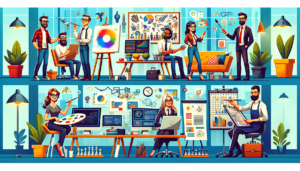Why you should get on board with blended learning
- 4 Min Read
If you are in L&D, you’re probably starting to feel the pressure from your customers to move into the 21st century. Learners want more and more from us, job-hopping has been on the rise as they search for better job satisfaction, culture fit, and career progression.
- Author: Stephanie Morgan
- Date published: May 21, 2018
- Categories

This has probably been a concern for you for some time, but it’s beginning to feel as if they’ve turned the volume up to 11. The press is full of stories about the changing workforce. We all have to evolve to survive—not just in L&D.
Why commit to a blended approach?
People want personal development. Whilst they might not be beating down our doors about it yet, the message we’re getting from the research already is loud and clear.
The main reason it’s going to be the hot topic for years to come is that young professionals especially value learning on the job. Research has shown that while a Baby Boomer or Gen X-er might have rated security, flexibility or pay as the most important factors in deciding whether to take a role, for today’s ‘millennial’ workers—the largest working generation—other things rate much more highly when considering their career path.
As Boomers retire, the Generation X-ers moving into senior positions and millennials are going to be a much bigger part of L&D’s audience. To attract and retain the right talent, you have to invest in your people; building learning culture, giving opportunities for continuous learning, using up-to-date technologies and enjoyable, absorbing learning content.
The workforce is changing
 However, Boomers and Gen X-ers are going to be a big part of L&D’s audience for a while yet. You need to be able to create learning programmes suitable for up to five generations of learners at a time—and this comes with its own unique considerations.
However, Boomers and Gen X-ers are going to be a big part of L&D’s audience for a while yet. You need to be able to create learning programmes suitable for up to five generations of learners at a time—and this comes with its own unique considerations.
Each may have different learning styles, be dispersed over many locations, and use different methods to access learning programmes. To make sure a training plan works best for all learners, adopting a blended learning mindset, with its emphasis on diversity and customisation, is the perfect way to make your content’s appeal as broad as possible.
By using a blend, not only do you have the best chance of engaging all types of learners, but you will also deliver different types of content, making up an exciting blend that will be retained and used.
The workplace is changing
37% of the global workforce is now mobile, 30% of full-time employees do most of their work outside of the employers’ location, and 20% is made up of temporary workers, contractors, and freelancers. A diverse workplace calls for diverse approaches, and blended learning offers more flexibility and adaptability than traditional L&D delivery methods. If people can’t access your learning, they won’t! Make sure your blend is optimised for mobile, so your people can access your learning whenever and however.
Learners’ expectations are changing
As we know, digital technology has made learning more accessible than ever. Just look at the amazing recent success of YouTube how-to video tutorials. In 2016, the beauty category on YouTube—i.e., makeup tutorials—was capturing about 4.5 billion views per month. Millennials are used to using digital assets to ‘pull’ learning down from their personal networks every day and will also expect this from your blend. Apart from being expert at accessing point-of-need learning, learners now want to learn because they’re used to learning. Language learning app Duolingo had 120 million users around the world in 2016, teaching 19 distinct languages. Learning’s position has changed from being ‘just one part of the job’ to something more all-pervasive.
So, expectations are high. Having a blend will enable you to weave the latest digital and social learning and be more innovative in your approach.
What now?
The launch of The Transformation Curve has set 2018 up as the year L&D should be embracing change, transformation and introducing new ways of thinking. So now really is the perfect time for you to start building a blended learning offer.
Author: Stephanie Morgan, Director of Learning Solutions, Bray Leino Learning









